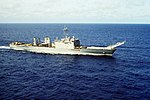
HMAS Success was a Durance-class multi-product replenishment oiler that previously served in the Royal Australian Navy (RAN). Built by Cockatoo Docks & Engineering Company in Sydney, Australia, during the 1980s, she is the only ship of the class to be constructed outside France, and the only one to not originally serve in the Marine Nationale. The ship was part of the Australian contribution to the 1991 Gulf War, and was deployed to East Timor in response to incidents in 1999 and 2006. The ship was fitted with a double hull during the first half of 2011, to meet International Maritime Organization standards.

HMAS Choules (L100) is a Bay-class landing ship that served with the Royal Fleet Auxiliary (RFA) from 2006 to 2011, before being purchased by the Royal Australian Navy (RAN). The vessel was built as RFA Largs Bay by Swan Hunter in Wallsend, Tyne and Wear. She was named after Largs Bay in Ayrshire, Scotland, and entered service in November 2006. During her career with the RFA, Largs Bay served as the British ship assigned to patrol the Falkland Islands in 2008, and delivered relief supplies following the 2010 Haiti earthquake.
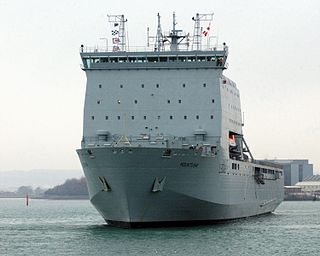
The Bay class is a ship class of four dock landing ships built for the British Royal Fleet Auxiliary (RFA) during the 2000s. They are based on the Dutch-Spanish Royal Schelde Enforcer design, and replaced the Round Table-class logistics ships. Two ships each were ordered from Swan Hunter and BAE Systems Naval Ships. Construction work started in 2002, but saw major delays and cost overruns, particularly at Swan Hunter's shipyard. In mid-2006, Swan Hunter was stripped of work, and the incomplete second ship was towed to BAE's shipyard for completion. All four ships, Largs Bay, Lyme Bay, Mounts Bay, and Cardigan Bay had entered service by 2007.
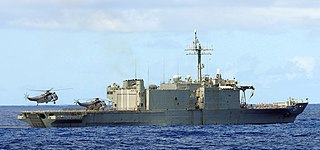
HMAS Kanimbla was a Kanimbla-class landing platform amphibious ship operated by the Royal Australian Navy (RAN). Originally built for the United States Navy (USN) as the Newport-class tank landing shipUSS Saginaw (LST-1188), the ship was decommissioned in 1994 and sold to the RAN.
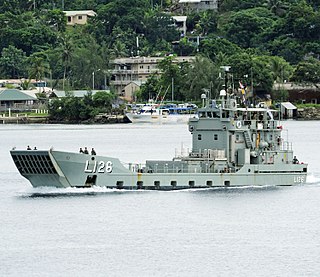
The Balikpapan class is a ship class of eight heavy landing craft. All eight were originally laid down by Walkers Limited for the Australian Army in the early 1970s. A reorganisation of watercraft responsibilities in the Australian military meant the landing craft were to be operated by the Royal Australian Navy (RAN), with seven commissioned directly into RAN service during 1973 and 1974, and lead ship Balikpapan transferred from the army to the navy. During the leadup to the independence of Papua New Guinea in 1975, two of the vessels were transferred to the new Papua New Guinea Defence Force (PNGDF).

HMAS Manoora was a passenger liner that served in the Royal Australian Navy (RAN) during World War II. She was built in Scotland in 1935 for the Cairns to Fremantle coastal passenger run for the Adelaide Steamship Company. She was requisitioned by the RAN for naval service in 1939. Manoora was initially converted into an armed merchant cruiser (AMC), operating primarily in Australian, New Guinea, and Pacific waters, with deployments to Singapore and the Bay of Bengal.

HMAS Manoora was a Kanimbla-class landing platform amphibious ship operated by the Royal Australian Navy (RAN). Originally built for the United States Navy (USN) as the Newport-class tank landing shipUSS Fairfax County (LST-1193), the ship was decommissioned in 1994 and sold to the RAN.

Newport-class tank landing ships were an improved class of tank landing ship (LST) designed for and employed by the United States Navy from 1969 to 2002. The ships were intended to provide substantial advantages over their World War II-era predecessors. Larger and faster than any previous LST design, they carried a ramp over the bow that allowed them to surpass 20 knots, a goal of the United States amphibious forces. 27 were planned of which twenty were completed, the high number due to the demands of US force projection estimates. However, the arrival of the air-cushioned landing craft which allowed for over-the-horizon attacks made the class obsolete in the eyes of the United States Navy. Placed in reserve, twelve were eventually sold to foreign navies, while the remaining eight have since been decommissioned.
The Royal Australian Navy, although a significant force in the Asia-Pacific region, is nonetheless classed as a medium-sized navy. Its fleet is based around two main types of surface combatant, with limited global deployment and air power capability. However, in 2009, a white paper, Defending Australia in the Asia Pacific Century: Force 2030, was produced by the Australian government which set out a programme of defence spending that will see significant improvements to the RAN's fleet and capabilities.

USS Saginaw (LST-1188) was the tenth of the Newport-class tank landing ships of the United States Navy which replaced the traditional bow door-design tank landing ships (LSTs). The second ship of that name, Saginaw was named after the river in Michigan. The LST was constructed by National Steel and Shipbuilding Company of San Diego, California, launched in 1970 and commissioned in 1971. During service with the United States Navy, the ship took part in US efforts in the Lebanese civil war and the Gulf War. Saginaw was decommissioned on 28 June 1994 and was transferred to the Royal Australian Navy on 28 August that year.
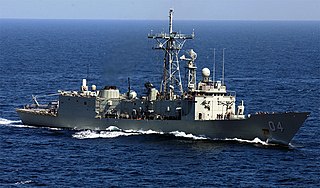
The Adelaide class was a ship class of six guided missile frigates constructed in Australia and the United States of America for service in the Royal Australian Navy. The class was based on the United States Navy's Oliver Hazard Perry-class frigates, but modified for Australian requirements. The first four vessels were built in the United States, with the final two being constructed in Australia.

The Canberra class is a ship class of two landing helicopter dock (LHD) ships built for the Royal Australian Navy (RAN). Planning to upgrade the navy's amphibious fleet began in 2000, based on Australian experiences leading the International Force for East Timor peacekeeping operation. With a new climate for growing Australian Navy spending, a desire existed for forward defence capability for landing and supporting troops on Asian territory, that had never existed in Australian history, even with the old Majestic-class light fleet carriers, HMAS Melbourne and HMAS Sydney in the 1970s. In 2004, French company Direction des Constructions Navales (DCN) and Spanish company Navantia were invited to tender proposals, with DCN offering the Mistral-class amphibious assault ship and Navantia proposing the "Buque de Proyección Estratégica" design. The Spanish design was selected in 2007, with Navantia responsible for construction of the ships from the keel to the flight deck, and BAE Systems Australia handling the fabrication of the combat and communications systems. Finally, Siemens (Germany) supplied and fitted the azimuth thrusters.

HMAS Tobruk was a Landing Ship Heavy (LSH) of the Royal Australian Navy (RAN), based on the design of the Round Table-class of the British Royal Fleet Auxiliary. Planning for the ship began in the 1970s to provide the Australian Army with a permanent sealift capability. She was laid down by Carrington Slipways in 1979, launched in 1980, and commissioned in 1981. She was a multi-purpose, roll-on/roll-off heavy lift ship capable of transporting soldiers, APCs, and tanks, and delivering them to shore via landing craft or directly by beaching.
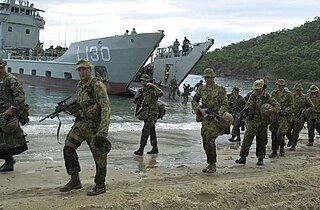
The Royal Australian Navy and Australian Army have operated 24 amphibious warfare ships. These ships have been used to transport Army units and supplies during exercises and operational deployments.
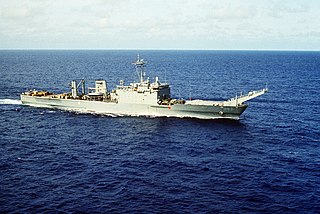
USS Fairfax County (LST-1193) was the fifteenth of twenty Newport-class tank landing ships of the United States Navy (USN) which replaced the traditional bow door-design tank landing ships (LSTs). Named after a county in Virginia, the ship was constructed by National Steel and Shipbuilding Company of San Diego, California. The LST was launched in 1970 and was commissioned into the USN in 1971. Fairfax County was alternated deployments between the Caribbean Sea and the Mediterranean Sea. During the Gulf War, Fairfax County was deployed off the northern African coast as part of a deterrent force. The ship was decommissioned from the USN in 1994.

HMAS Canberra (L02) is the first ship of the Canberra-class landing helicopter dock in service with the Royal Australian Navy (RAN) and is the second largest in the Navy, succeeded by its sister ship HMAS Adelaide (L01). Construction of the ship started in Spain in 2008, with the hull launched by Navantia in 2011. The hull was then transported to Australia in late 2012 for completion by BAE Systems Australia. Canberra was commissioned on 28 November 2014.

Australian Border Force Cutter (ABFC) Ocean Shield is an offshore patrol vessel operated by the Australian Border Force. The ship was originally ordered in 2010 by DOF Subsea as an offshore support vessel, and was laid down by STX OSV as MSV Skandi Bergen in 2011. In 2012, the Australian Department of Defence was seeking a short-term replacement for the decommissioned Kanimbla-class amphibious landing ships, and negotiated to purchase the under-construction Skandi Bergen from DOF Subsea. The ship was completed, and entered Royal Australian Navy (RAN) service in mid-2012 as the civilian-crewed Australian Defence Vessel (ADV) Ocean Shield.

